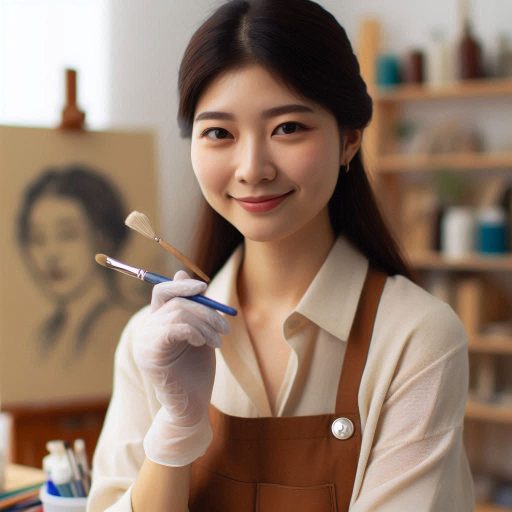Introduction
Professional organizations play a vital role in the career development of art conservators.
These organizations provide a platform for networking, continuing education, and professional growth.
Joining these organizations can enhance one’s skills, knowledge, and opportunities in the field of art conservation.
Benefits of Joining Professional Organizations
- Networking Opportunities: Professional organizations offer a chance to connect with other art conservators, potential employers, and experts in the field.
Networking can lead to collaborations, job opportunities, and mentorship. - Continuing Education: Membership in professional organizations provides access to workshops, seminars, and conferences focused on the latest techniques, research, and trends in art conservation.
This ongoing education is essential for staying current in the field. - Professional Recognition: Being part of a reputable professional organization can enhance one’s credibility and reputation as an art conservator.
It demonstrates a commitment to excellence and high standards in the practice of conservation. - Advocacy and Support: Professional organizations advocate for the interests of art conservators, promote ethical practices, and provide support in challenging situations.
They can also offer resources for career development, such as job boards and certification programs. - Access to Resources: Members of professional organizations can access a wealth of resources, including publications, online forums, and research databases.
These resources can help art conservators stay informed and engaged in the field.
In essence, joining professional organizations for art conservators is essential for career advancement and professional development.
The benefits of networking, continuing education, professional recognition, advocacy, and access to resources make membership in these organizations highly valuable for those in the field of art conservation.
What are professional organizations for art conservators?
Definition of professional organizations
Professional organizations for art conservators provide vital support to individuals preserving cultural heritage.
These organizations create networks that connect professionals, share knowledge, and establish industry standards.
They play a significant role in guiding conservators by offering resources, training, and advocacy.
Role of professional organizations in supporting art conservators
Professional organizations help art conservators maintain high standards through certifications and continuing education programs.
They promote ethical practices and research advancements that enhance conservation techniques.
Through conferences and publications, members stay updated on trends and innovations in the field.
Examples of well-known professional organizations in the field
Well-known organizations like the American Institute for Conservation (AIC) and the International Institute for Conservation (IIC) offer conservators valuable tools and resources.
These groups provide opportunities to learn, grow, and engage with peers.
The Canadian Association for Conservation and The European Confederation of Conservator-Restorers’ Organizations also serve as vital networks for professionals across the globe.
By joining these organizations, art conservators can access critical professional development opportunities.
Members benefit from workshops, conferences, and certification programs that improve their skills and knowledge.
Furthermore, these organizations provide advocacy, ensuring the importance of conservation is recognized and supported.
Overall, professional organizations serve as an essential foundation for art conservators.
They connect conservators worldwide and offer resources to help them succeed in their careers.
The role they play in shaping conservation standards and promoting best practices makes them indispensable to the field.
Transform Your Career Today
Unlock a personalized career strategy that drives real results. Get tailored advice and a roadmap designed just for you.
Start NowRead: How to Choose an Art Conservation Specialty
Benefits of joining professional organizations for art conservators
Joining professional organizations for art conservators can offer numerous benefits:
Advantages of Networking with Other Professionals
- Networking allows conservators to connect with colleagues in the field.
- Sharing ideas, experiences, and best practices can help improve conservation techniques.
- Collaboration on projects with other professionals can lead to innovative solutions.
Opportunities for Professional Development and Continuing Education
- Professional organizations often offer workshops, conferences, and seminars.
- These events provide valuable learning opportunities and allow conservators to stay current.
- Access to resources, such as research materials and publications, can further enhance skills.
Enhancement of Credibility and Expertise
- Membership in a professional organization demonstrates a commitment to the field.
- It shows that the conservator is dedicated to staying informed and engaged.
- Being part of a reputable organization can increase credibility among peers and clients.
In fact, joining professional organizations for art conservators can be highly beneficial for networking, professional development, and enhancing credibility.
By actively participating in these groups, conservators can stay connected, informed, and respected within the field.
Read: Balancing Art and Science in Conservation Work
Types of Professional Organizations for Art Conservators
Professional organizations play a crucial role in the art conservation field, providing support, resources, and networking opportunities for professionals in this niche industry.
There are various types of professional organizations for art conservators, each serving a unique purpose and audience.
Differences between local, national, and international organizations
Local Organizations
Local organizations cater to art conservators working in a specific region or area.
These organizations often host events, workshops, and conferences that focus on local conservation issues and practices.
They provide a platform for professionals to connect with colleagues in their community and collaborate on projects.
National Organizations
National organizations encompass a broader scope, representing art conservators at a national level.
They advocate for the profession, set industry standards, and offer certification programs for members.
National organizations often organize large-scale conferences, training programs, and research initiatives that benefit conservators across the country.
International Organizations
International organizations bring together art conservators from around the world, fostering global collaboration and knowledge exchange.
These organizations host international conferences, seminars, and exhibitions that showcase the latest advancements in conservation practices.
They play a vital role in promoting cultural heritage preservation on a global scale.
Specialized Organizations for Specific Areas of Conservation
Paper Conservation Organizations
Specialized organizations focused on paper conservation cater to professionals who specialize in the preservation of paper-based artworks and documents.
These organizations offer specialized training, resources, and research opportunities for paper conservators.
They address unique challenges related to paper conservation, such as deacidification, mold remediation, and repair techniques.
Paintings Conservation Organizations
Organizations dedicated to paintings conservation support professionals working with oil, acrylic, and watercolor paintings.
These organizations offer workshops, symposiums, and publications that focus on best practices for the care and treatment of paintings.
They provide access to specialized tools, materials, and techniques for conserving painted artworks.
Textiles Conservation Organizations
Textiles conservation organizations cater to conservators specializing in the preservation of textiles, garments, and tapestries.
These organizations offer training programs, workshops, and resources for textile conservators.
They address challenges specific to textile conservation, such as cleaning, stabilization, and mounting techniques for fragile textiles.
Whether you are a local art conservator looking to connect with peers in your community or an international conservator seeking global networking opportunities, there is a professional organization that can support your professional development and growth in the field of art conservation.
Joining a professional organization can provide you with access to valuable resources, mentorship opportunities, and a supportive community of colleagues who share your passion for preserving cultural heritage through conservation.
Read: How to Break into the Fashion Industry Without a Degree

Membership requirements and fees
Typical requirements for joining a professional organization
Joining a professional organization for art conservators typically requires meeting certain criteria:
- A degree in art conservation or a related field
- Professional experience in art conservation
- Letters of recommendation from other professionals in the field
Different membership levels and associated fees
Membership levels in these organizations often vary, with different benefits and associated fees:
- Student membership: For those currently enrolled in a relevant academic program
- Associate membership: For entry-level professionals or those working towards full certification
- Full membership: For established professionals with significant experience in the field
Membership fees also vary, with student memberships being the most affordable and full memberships typically being the most expensive.
These fees help support the organization’s programs and activities.
Scholarships or financial assistance available
Some professional organizations for art conservators offer scholarships or financial assistance to help offset the cost of membership:
- Merit-based scholarships for students or early-career professionals
- Need-based financial assistance for those facing financial barriers to membership
- Discounted rates for members from developing countries or regions with limited resources
These scholarships and financial assistance programs aim to promote diversity and inclusion within the field of art conservation by making membership more accessible to individuals from a variety of backgrounds.
Read: Historical Art Conservation Success Stories
Resources and support provided by professional organizations
Professional organizations for art conservators offer a wide range of resources and support to their members.
These resources are essential for the professional development of conservators and help them stay updated on the latest trends and techniques in the field.
Types of resources and support available
- Access to online databases and research materials
- Networking opportunities with other conservators
- Discounts on conferences and workshops
- Job postings and career development resources
- Continuing education programs and certifications
These resources can help conservators enhance their skills, expand their knowledge, and stay connected with others in the field.
Publications, conferences, and workshops
Professional organizations often publish journals, magazines, and newsletters that offer valuable insights and information on art conservation.
These publications are excellent resources for staying informed about new research, techniques, and best practices in the field.
In addition, these organizations frequently organize conferences and workshops where members can learn from experts, attend lectures and presentations, participate in hands-on training sessions, and network with colleagues.
Mentorship programs and volunteer opportunities
Many professional organizations for art conservators offer mentorship programs that pair experienced conservators with newcomers to the field.
These programs provide guidance, support, and advice to help new conservators navigate their careers and develop their skills.
Volunteer opportunities are also available through these organizations, allowing members to give back to their communities, gain practical experience, and make a difference in the preservation of cultural heritage.
Overall, professional organizations for art conservators play a crucial role in supporting the growth and success of conservators by providing them with the resources, education, and connections they need to excel in their careers.
Uncover the Details: Illustration Trends to Watch in the Coming Year
Code of ethics and professional standards
In the field of art conservation, adhering to a code of ethics is of utmost importance.
It ensures the integrity of the work being performed and upholds the trust of the clients and the public.
Why Adhering to a Code of Ethics is Important
- Maintaining Trust: By following ethical standards, art conservators build trust with their clients and demonstrate their commitment to preserving cultural heritage.
- Ensuring Quality: Adhering to ethical guidelines helps ensure that conservation treatments are carried out with the highest standards of quality and care.
- Protecting Cultural Heritage: By following ethical codes, conservators help safeguard valuable artworks and artifacts for future generations.
How Professional Organizations Promote Ethical Standards
Professional organizations play a crucial role in promoting and enforcing ethical standards within the field of art conservation.
They provide guidelines and resources for conservators to follow, ensuring ethical practices are upheld.
- Code of Ethics: Professional organizations create and maintain a code of ethics that members are expected to adhere to.
This code outlines the principles and values that conservators must uphold in their work. - Training and Education: Organizations offer training programs and educational resources to help conservators understand and apply ethical principles in their conservation work.
- Professional Development: By encouraging ongoing professional development, organizations help conservators stay abreast of current ethical standards and best practices in the field.
Examples of Ethical Dilemmas
Art conservators often face ethical dilemmas when making decisions about how to treat and preserve artworks.
Professional organizations provide support and guidance in addressing these dilemmas to ensure that ethical standards are upheld.
- Authenticity: Conservators may face dilemmas when dealing with issues of authenticity and provenance of artworks, especially in cases where there is uncertainty about the history of the piece.
- Intervention: Choosing the appropriate level of intervention in conserving an artwork can be a dilemma, as conservators must balance the need to preserve the original integrity of the piece with the necessity of stabilizing and protecting it.
- Cultural Sensitivity: When working with culturally sensitive materials or objects, conservators must navigate ethical considerations to ensure that their actions respect the cultural significance and values associated with the artwork.
How Organizations Address Ethical Dilemmas
- Guidelines and Best Practices: Professional organizations provide guidelines and best practices to help conservators navigate ethical dilemmas and make informed decisions that align with ethical standards.
- Peer Support: Organizations offer opportunities for conservators to engage with their peers and seek advice and feedback on ethical dilemmas they may encounter in their work.
- Ethics Committees: Some organizations have ethics committees that are responsible for reviewing and addressing ethical concerns raised by conservators and ensuring that ethical standards are upheld within the profession.
In general, professional organizations play a vital role in promoting and enforcing ethical standards within the field of art conservation.
By adhering to a code of ethics and seeking guidance from these organizations, art conservators can uphold the integrity of their work and contribute to the preservation of cultural heritage.
How to choose the right professional organization for you
When it comes to selecting a professional organization for art conservators, it is essential to consider your specific needs and interests.
Here are some tips to help you evaluate and choose the right organization for you:
Evaluate different organizations based on your specific needs
- Consider the focus of the organization – does it align with your professional goals?
- Look at the benefits offered – such as networking opportunities, educational resources, and certifications.
- Assess the membership requirements – are they in line with your qualifications and experience?
- Review the organizational structure – do you prefer a large, established organization or a smaller, niche group?
Research and compare organizations before joining
- Visit the websites of different organizations to learn more about their mission, values, and activities.
- Read reviews and testimonials from current and past members to get an idea of their experiences.
- Attend events or conferences hosted by the organizations to get a firsthand look at what they have to offer.
- Reach out to other professionals in the field for recommendations and insights on the different organizations.
Reach out to current members for feedback and recommendations
- Contact current members of the organizations you are interested in to ask them about their experiences.
- Inquire about the benefits they have gained from being a part of the organization and how it has helped their career.
- Ask about any challenges or drawbacks they have encountered while being a member of the organization.
- Seek recommendations on which organization would be the best fit for your specific interests and goals.
By taking the time to thoroughly evaluate and compare different professional organizations for art conservators, you can make an informed decision on which one is the right fit for you.
Remember that joining a professional organization can provide valuable networking opportunities, educational resources, and support for your career growth.
See Related Content: Career Paths in Film and Television Design
Gain More Insights: The History and Evolution of Jewelry Design
Conclusion
Art conservators can benefit greatly from joining professional organizations.
These groups offer networking opportunities, access to resources, and continuing education.
By becoming a member, art conservators can stay up-to-date with industry trends and developments.
They gain a sense of community and support from like-minded professionals.
The significance of joining a professional organization cannot be overstated.
It is a valuable investment in one’s career growth and development.
Art conservators are encouraged to explore different organizations that align with their interests and goals.
By taking advantage of professional development opportunities, they can enhance their skills and expertise.




